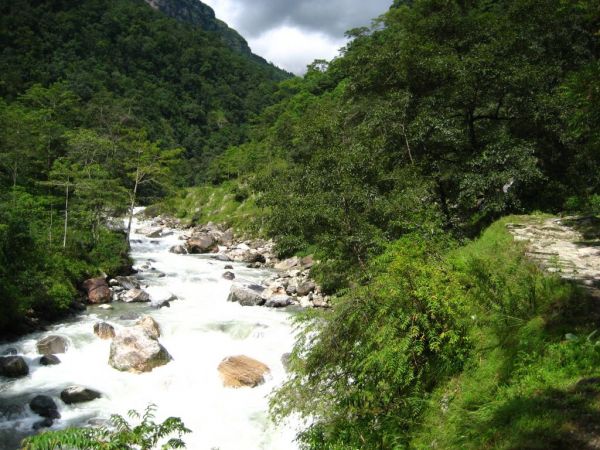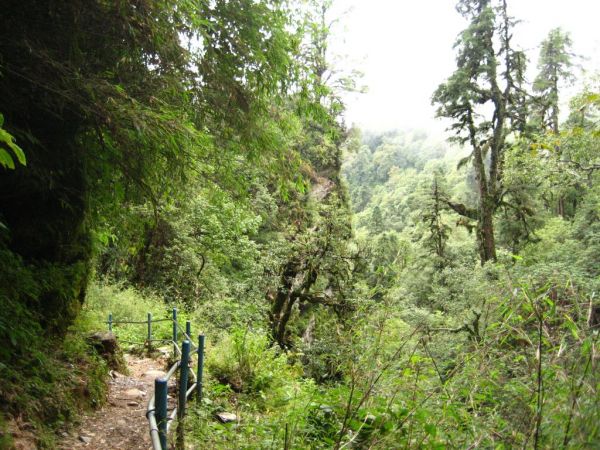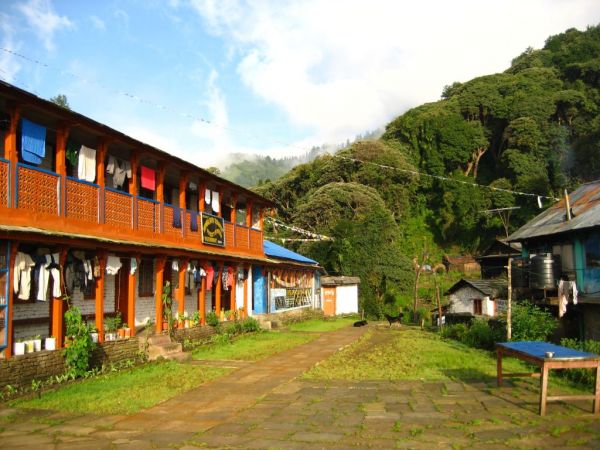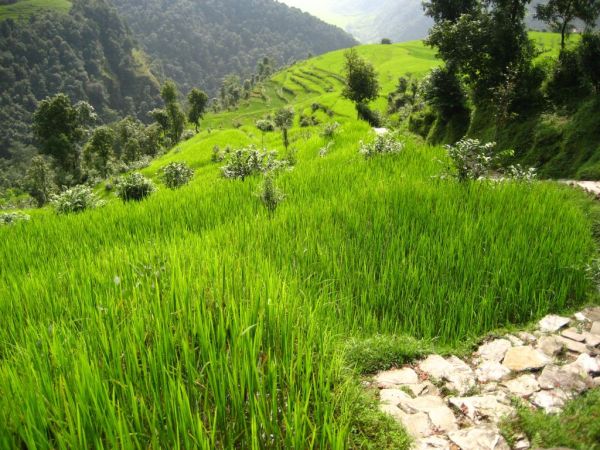A short stop in Kathmandu to get the Indian visa before leaving to Pokhara and the protected area of the Annapurnas. The most mythical treks are called the Annapurnas circuit in 17 days or the Annapurnas sanctuary in 12 days. But I don't have enough time to step on of these trips and a travel agency in Kathmandu offers me a 6-day trek, "the Annapurnas panorama". I make Gyan Gurung's acquaintance who comes with me for these 6 days. A about-50-year smiling small Nepali.
The next day in the morning, departure to Pokhara, a 7-hour bus journey. En route, we drop a few tourists off at Dumre ; from there, they'll go to Besi Sahar and start the Annapurnas circuit. At Pokhara, the hostels string along the lake. Relaxing atmosphere far from the hubbub of Kathmandu. A panoramic photo hanging at the wall of the guesthouse reception leaves me wondering. With a clear weather, the lake reflects the 7000 and 8000-metre giants of the area but I must satisfy myself with the wall picture.
I wander around in the tourist street of Pokhara before getting my permit for the protected area of the Annapurnas. A simple pass to get in the park. I devour a dish of spaghetti before falling asleep, the soul sprinkled with eternal snow. Tomorrow, it's the D-day.
Day 1 : Naya Pul => Hile
A local minivan drops us off at Naya Pul, 1h30 from Pokhara. We put our bags onto our shoulders and we disappear into the alleyways maze of the village. First monkey bridge to cross the river and record to the park authorities. You must register your journey, your name and the numbers of the days inside the park.

A path fades into the distance. I'm happy to rub my shoes ontot the muddy trails of this gorgeous Nepali nature. We walk along the river. The monsoon rains wreak havoc. The path is sometimes impassible and we must cross the turbulent waters of the river to carry on pacing on the other bank. This first stage is short and we arrive at the village of Hile. A pile of corrugated sheet metal on multicoloured wooden frame with various signs : restaurant, guesthouse, delicious food, hot shower. The monsoon is synonymous with low season, and I'm the only one in this gathering of guesthouses. And for 1 euro a night, it would be a pity to cart the tent around. The laid-back atmosphere lets me realize the pleasure to be here. To look at the terraced fields of the opposite hill disappearing while the twilight goes down.








Day 2 : Hile => Ghorapani
Steps and steps again. An exhausting ascent which pulls me out liters of sweat. Difference of height : 1200m. More or less high, wood or stone, stairs became a leitmotiv. The head raises to peer what happens next but it's often with a low and shifty look it draws on its energy to order the legs to lift and go forward. Big drops stream down on my face and crash on the stone steps. The eyes forget the surrounding scenery and all the energy runs into the quadriceps. The suffering reads on the other madmen's face who came to the hard nature of the Annapurnas searching a bit of relaxation and cool air. Ghorapani. An incomparable satisfaction overwhelms me when I take off my shoes and hang my socks that keep the fruits of the effort among its stitches. In front of me, the mountains are not there. Where are the Annapurnas and the Dhaulagiri ? Behind the thick curtain of clouds. The comfort of a chair and a meal of pasta fully satisfy me.













Day 3 : Ghorapani => Tadapani
The alarm-clock rings. The dial displays 5h. I bend my head through the window and nothing sparkles in the sky. We cancel the morning ascent to Poon Hill, promontory to contemplate the sunrise over the snow-capped massif. At a more decent time to get up, azure-hued windows break through the greyish wall. The majestic Dhaulagiri and Annapurna I loom. I give a withering look at the ridges and spurs of the Annapurna I and start thinking of Maurice Herzog and Louis Lachenal who 50 years ago became the first alpinists succeeding in the ascent of a 8000-meter-plus peak. The desire of reading the story of this adventure devours me. A small library in Ghorapani luckily has a copy relating the saga of the French expedition : "Annapurna, first 8000m". The precious book at the bottom of my rucksack, we venture on a new section of stairs.




3000m high, a disused refreshment stand mingles with the sadness of the weather. Our wait will change no way. We get in a forest of rhododendrons. Twisting bodies which vivid-shaded flowers extend when the spring comes. River and waterfalls, majestic trees among a coulis of downy clouds, corniche stroll. The menu is mouth-watering. And for this trek I thought walking into the snow, onto a sterilized ground, onto uneven stones. Nothing of these, a green and twirling nature. A crystal-clear water that fills the ears when the eyes are busy to check where the feet land. Overdose of colours. The path plays with the water. Timber logs straddle the river and we leap from a bank to another.












Arrival at Tadapani, my eyes finally rest coming and going on the first lines of the adventure of Maurice Herzog. The sacred moutain of the Machhapuchhare breaks through the horizon. Silence... A band of admirers have just stood up. The snows of the Annapurna south twinkle. Still silence... The orangeay shade get thicker up to fade into the darkness of the nascent night. The pages of the book come and go endlessly.












Day 4 : Tadapani => Landruk
The trunks of the rhododendrons start again their waltz. A young Nepali takes off the numerous leeches hanged at his bloodstained feet. Luckier, I would only have 2. A little bit further, a buffalo shows us the ability of these horrible beings to drink blood. The diameter of these awful beasties has swollen from one millimeter to more than one centimeter. As for the eyes, they don't make a mistale. The spectacle is more aerial. Jungle and mountains. Lovely oxymore.







Day 5 : Landruk => Pothana
Short day. A simple stroll. The jungle fades into the distance and the rice fields loom. I finish the Himalayan saga of Maurice Herzog and Louis Lachenal who a certain 3rd of june 1950 opened the run to the conquest of the 8000-meter-plus peaks.


Day 6 : Pothana => Phedi => Pokhara
We reach the village of Dhampus and embark on a long walk down toward Phedi. The spectacle of the Annapurnas close. I live my last moments with my guide Gyan Gurung I'm attached to. But on the way back to Pokhara, sitting in this tottering coach, I fall asleep. And I am firmly convinced these mythical paths on the spurs of the Himalaya will see again my Vibram soles and Gyan Gurung will join in...
End of the Nepali adventures...


RTW-Nepal
Wednesday 12 September 2007
Panorama on the Annapurnas
By dorian on Wednesday 12 September 2007, 18:47
Monday 3 September 2007
In pursuit of the one-horned rhinoceros
By dorian on Monday 3 September 2007, 16:51
A dal bhat (Nepali traditional dish) in the stomach after this thrilling sail down, I wait by the road for a coach that goes to the Chitwan national park. They load my big rucksack on the roof of the bus and this one starts again. A few hours later, the coach drops me off as we cross the city of Narayanghat. A horde of touts surround me but I draw the lethal weapon saying I've already booked a room in a lodge. At this time, somebody approaches me, I hop on the back of his motorbike and we leave to the bungalows camp, not far from the park entrance. We leave the main road for muddy paths and a vague feeling of freedom. The afternoon is quite over and the twilight turns up. The stroll planned for the afternoon is canceled and I directly carry on the dinner. Vegetarian escalope. African specialty. The darkness covers the camp and is the harbinger of a relaxing night.
The next morning, after a quickly swallowed breakfast, I mount the motorbike to go by a river which flows through the park. The gondolier settles 2 chairs at the front of his boat, then he pushes the bank back with the paddle. We slowly sail down the river watching myriad of birds fluttering and chattering into the air. Into the water, taciturn crocodiles and ill-fitted-teethed gavials despise us and keep on resting. These first hectometers intoxicate me. Superb blue-breasted kingfishers ferret around on the top of branches. The Nepali gondola drops us off on a bit of marshy meadow while the trees of the opposite bank are reflected in the water and welcome us.





We swap the wooden chairs for a pair of binoculars the guide carries with a shoulder strap and leave to meet the animals of the forest. We juggle the clods of earth and sometimes end onto a sponge-like turf. A little bit further, in the undergrowth, the surface of a transient lake gives a tribute to the knotty trees of its shore. An eerie shimmer throws into a fairy tale. The guide spies every move and every sound behind the bushes. We disturb some deers which run away. The squeaking of our steps don't belong to their range of known and accepted sounds.




Our loop ends at the elephants breeding center. Several young and less young, shamefully tied specimens trudge their imposing old bones covered with a thick grey skin. Nothing more than a mini-zoo. We cross the river and go back to the camp to have lunch.







In the beginning of this afternoon, our jeep goes by the different camps to pick up tourists, then follows the path on the edge of the park. With 2 Japanese, I share the square dome harnessed on the back of an elephant. The elephant driver grabs one of its ears, leans his foot on the trunk and mounts onto the elephant's neck. He places his feet behind its big ears and communicates with the quadruped like that. Its gangling walk shakes us all over the place but I won't swap my seat for the most comfortable armchair. Let's go for the elephant safari! I'm surprised at the obedience of the giant quadruped. It does the elephant driver commands, "turn right", "turn left", "faster", "stop" and all of those, only with the feet pressing on its ears. When a branch or a shrub hinders the way, the elephant driver shouts an order, the trunks raises, seizes the hindering branch and rips it off with an astonishing ease. But the elephant has its mood swing as well and a stick is there to remain it back the boss of the stroll. A knock on the frontal bone vents a muffled sound we hear resonating and spreading along the cranium bones of the powerful animal.
The grass is beyong 3m high and the elephant unchangeably goes forward. Our eyes look for the animal presence. And despite the noise made by the pachyderm during its walk, animals let us approach. The small human beings perched on its back are forgotten and we take part in the animal kingdom. Beautiful deers eat and male peacocks attempt to win the female. We won't see the fierce Bengal tiger which however ornates every billboard of the Chitwan park. Their dangerously low number is threaten by the smugglers who make a fortune selling them to their Chinese neighbours. The organs of the tiger are in the composition of the so-called miraculous medicines of the traditional Chinese medicine.






On the way back, my eyes get a familiar feature in the distance. Familiar since I was child and glanced through animal books. A superb breast-plated quadruped sets off with a horn on the snout. Our safari reaches its climax. Like kids, and sorry to disturb its serenity, we admire this fabulous rhinoceros. It only drinks in a small pond and this trivial, daily moment changes into an exceptional and magical time for me. And for a long time, I'll talk about this rhino I admire from the back of an elephant somewhere at the borders of Nepal.%%




Saturday 1 September 2007
Rafting into the white water of the Trisuli river
By dorian on Saturday 1 September 2007, 15:49
It rains early in the morning. I have an appointment with the responsible of the rafting agency in front of my hotel. We together head for the bus station where coaches leave from to the western town of Pokhara. Most of the buses are the Indian brand Tata. The Tata company belongs to a wealthy family which supplies all the Indian subcontinent with millions of vehicles. And according to the Italian I met yesterday, Tata makes business with Fiat. We soon might have Tata taxis with multi points injection engine!
The departure by rafting is 3 hours from Kathmandu, a few meters below the road. I team up with a Chinese group who is more made for working in a shanghaian skyscraper than paddling. 3 boats form the cortege and just after a few meters, the opposite Chinese at the front side of the raft isn't a good match. He more strokes the water than truly rowing so much so that the raft starts turning and it's difficult to keep the right direction. The second Nepali guide quickly takes his place and we beat time putting ourselves through the helmsman's orders.
The monsoon still waters this part of the country and the level of the river is high. The rains drain the hill lands and colour the river with ochre shades. The rough current promises good thrills. The helmsman endeavours to avoid no eddying areas. We zigzag from a bank to the other one to actively involve into these swirls. The other rafts manage pretty well. So do we. We take off from the first wave, crash and sink into the next one. The feet wedged under the inflate crosspieces, we attempt to cling the water while a muddy liquid goes over and fills the boat. But the most beautiful head-on attack is credited to the second raft that succeeds in wholly going under a wave. As a result, it loses one of its rower, worried to float among the white water. We have a great time for the 25-km sail down. The Nepali adventures only begins...







Everybody knows Nepal for its wonderful treks and breathtaking summits. Feeling like relaxing your legs without stagnating in the polluting atmosphere of Kathmandu, let you plunge into the tempting thrills of the Nepali rivers.
« previous entries - page 1 of 2






 visits
visits